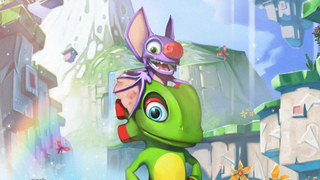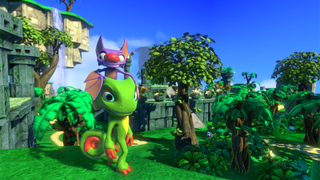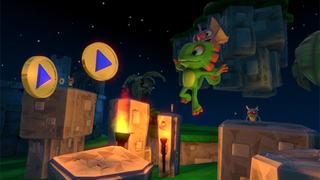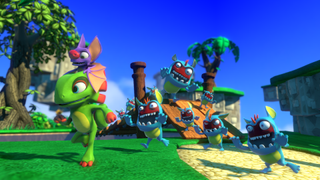Yooka-Laylee brings 3D platformers back from the dead

On an unassuming business park somewhere in the West Midlands, in an office smaller than most people’s living rooms, a group of games industry veterans are busy working on a 3D platformer called Yooka-Laylee. It’s the spiritual successor to Nintendo 64 classic Banjo-Kazooie—a game many of this close-knit team worked on together back in 1998—and it’s on track to becoming the most-funded UK Kickstarter ever.
I sit down at the desk of creative lead Gavin Price and he gives me the pitch. This is their attempt to revive the classic 3D platformers of the ‘90s, but with a contemporary edge. It has all the hallmarks of the genre—cute characters, colourful levels, spinning collectibles—but there’s a lot more going on behind the scenes. Powered by the latest version of the Unity engine, Yooka-Laylee will benefit from advanced physics, modern visual effects, and AI-powered enemies.
It’s only been in development for three months, but they have a remarkably polished prototype up and running. Price picks up an Xbox controller and leaps around a beautiful-looking jungle world as he speaks. If this was a triple-A project, he tells me, they’d still be at the concept stage, running ideas and artwork past a publisher. But thanks to the team’s years of experience, the freedom of indie development, and the accessibility of Unity, they’re already making impressive progress.

He hands me the controller and I take Yooka and Laylee for a spin. Yooka’s a chameleon and Laylee’s the small purple bat who clings to his head. Price says they’ve pretty much finalised the character movement, and it feels fantastic. It has that solid, bouncy, responsive feel that defines the best 3D platformers.
I squeeze the right trigger and Yooka curls into a ball, transitioning smoothly into a fast roll as Laylee balances on him like a circus clown. The twitchy camera needs work, but I’m amazed by how good it feels to play, even at this early stage.
Yooka and Laylee were designed by character artist Steve Mayles. In the past, working with Rare, he designed not only Banjo and Kazooie, but the modern incarnation of Donkey Kong that’s still being used by Nintendo today. He joins us as we play and talks about the design process. They work in such close quarters here that all he has to do is spin his chair around. They didn’t want a main character that looked too heroic, he tells me. They wanted a more unlikely hero. A scrappy underdog.

Vibrant, detailed animation gives the duo their personality. I love how, despite being much smaller, Laylee strides atop Yooka’s head like she’s the one who’s in charge. Hit the jump button twice and she’ll grab him and flap her tiny wings, letting the pair float in the air for a short period of time.
The biggest gaming news, reviews and hardware deals
Keep up to date with the most important stories and the best deals, as picked by the PC Gamer team.
I watch Mayles tinker with an animation on his computer, frame by frame, and it’s clear how much love is being poured into how the characters move. Basing them on real animals, Price explains, gives them a real-world reference point to base their powers on. They’ll be fantastical, but rooted in reality. Yooka, being a chameleon, will be able to take on the physical properties of objects, for example.
Technical director Jens Restemeier is responsible for programming the game, and he shows me a few things he’s working on in Unity. He’s experimenting with a squirming, physics-driven tentacle that bends realistically as Yooka walks into it. He shows me a transparent bridge that becomes solid when a button is stepped on. These elements will, eventually, be part of a level that doesn’t exist yet, but for now they’re isolated to these blank, untextured test chambers.

While they rely on Restemeier to create the complicated stuff, the accessibility of Unity means other team members—even if they have no coding experience—can go in and place simple objects like moving platforms. Yooka-Laylee’s development is collaborative in a way that’s just not possible with a huge team. Fifteen people worked on Banjo-Kazooie, and Playtonic want to expand to a similar number in the near future. They have creative freedom some developers could only dream of, and a steady flow of income thanks to the runaway success of their Kickstarter.
The last desk on my whirlwind tour of the Playtonic office belongs to Chris Sutherland, project director. He was the lead engineer on a long list of classic Rare games including Donkey Kong Country and Banjo-Kazooie. He shows me a new detail they’ve added to the way Yooka runs. As you turn in a direction, he’ll lean into it, giving his movement a feeling of weight and momentum. Most people won’t consciously notice them, but these little details are important in a game like this.
Playtonic have only just begun their journey, but Yooka-Laylee is already taking shape. As I write this they’ve raised almost £1.6 million on Kickstarter, and there are still 32 days to go in the campaign. Although publishers seem to have abandoned the 3D platformer, this proves there’s an audience for them out there. It’s also great to see a game like this make a rare appearance on PC. The 3D platformer joins space sims and adventure games as a forsaken genre brought back to life by crowdfunding, and you couldn’t ask for a better group of people to lead its revival.
If it’s set in space, Andy will probably write about it. He loves sci-fi, adventure games, taking screenshots, Twin Peaks, weird sims, Alien: Isolation, and anything with a good story.
Most Popular

